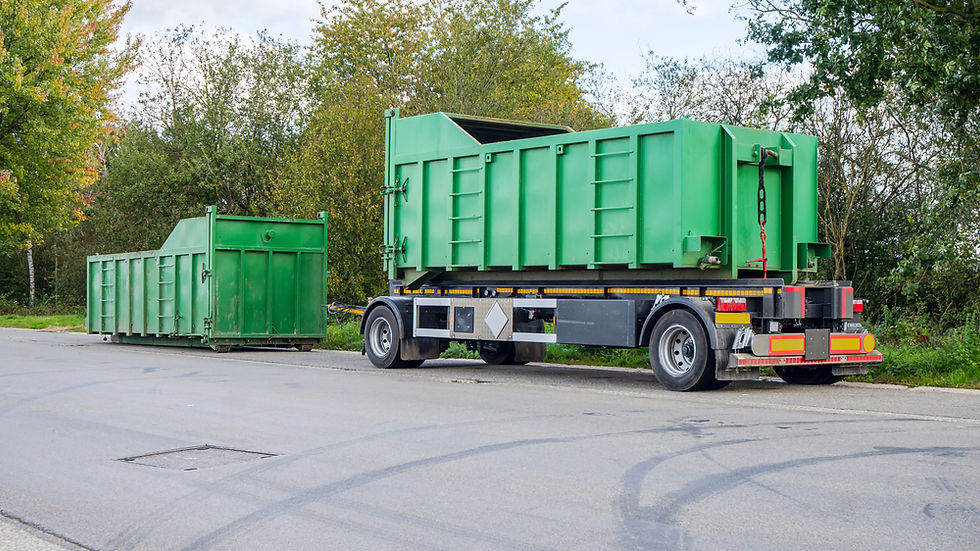How-To Choose the Right Skip Bins for Your Home Project
- annawrench1315
- Aug 12
- 7 min read
Do you ever stand in your driveway, stare at a mountain with renewal residue and think it all comes to earth? Or maybe you are planning to clean a large garden and feel overwhelmed by the large amount of green waste? What is clear about the garage for such a long time as has been on your two-do list for months?
If you go together, you are not alone. Thousands of homeowners in Australia meet the same dilemma every day. The solution? Skip bins. But here's the thing choosing the right skip bin for your home project in Doncaster isn't as straightforward as you might think.
Types of Skip Bins Available for Home Projects
Not all skip bins are made the same. The type you choose depends on the use of your property, the nature of the waste and how the garbage should be distributed and collected. Let's break your options.
Marrel Skip Bins
Marrel bins are the workhorses of the skip bin world. These are the traditional bins you've probably seen countless times rectangular containers that get delivered by trucks with hydraulic arms. They're perfect for most residential projects because they come in various sizes and can handle mixed waste types.
Hook Lift Bins
Hook lift bins are vigorous fee options, which usually start at 12m so and go to 30 meters groups. They have been loaded and unloaded using a hook system, which means that the truck can place them in tight places compared to the Maril room. If you are doing a major renewal or demolition project, this may be your best condition. Just remember that they need solid, even country to sit.
Mobile Skip Bins
Mobile skip bins have wheels, making them perfect for limited access properties or when you need to move the trash can during the project. They are usually small (2–4 m has) but are incredibly convenient for garage character or garden projects where you work in different fields. Some standards also fit through the gate, which is luxurious for renewal indoors.

What Can and Can't Go in a Skip Bin?
This is where things get a little technical, but it is important to correct it. Inserting wrong objects in the skip bin can lead to extra fees or even rejection of the entire load.
General Household Waste Guidelines
Most domestic goods are fair games for skip bins. It includes renewable materials such as furniture, normal nonsense, garden waste, tiles and plasterboard, metal, wood and cardboard. Mixed loads are typically fine, though some companies offer cheaper rates for single material loads like green waste or clean concrete.
Prohibited Items and Why They're Restricted
Some elements are not complete in the skip bins. These include asbestos, chemicals and paints, batteries, tires, gas bottles and medical waste. Food waste is also usually prohibited because it attracts pests and creates hygiene problems. If you eliminate banned items on landfill, your jump bin company can meet vigorously.
Recycling Options for Special Materials
Don't despair if you've got prohibited items to dispose of. Most councils offer free drop-off points for paint, batteries, and chemicals. Scrap metal dealers will often collect large metal items for free. For asbestos, you'll need a licensed removalist, but it's worth the peace of mind. Many skip bin companies can point you towards appropriate disposal methods for items they can't accept.
How Much Does Skip Bin Hire Cost?
Let's talk money. Skip bin hire costs vary more than the expectation and understanding the pricing structure helps you avoid the exact budget and surprise.
Factors Affecting Skip Bin Prices
Several factors influence skip bin costs. Size is the obvious one bigger bins cost more. Hire duration matters too; most companies offer standard periods of 3-7 days, with daily charges for extensions. The type of waste affects pricing, with mixed heavy waste costing more than green waste.
Hidden Fees to Watch Out For
Always ask for extra fees. Mango Extra includes permits if the garbage goes on the road, the overweight fees if you are more than the weight area, and pollution fee for banned goods. Some companies charge for delivery or specific time slot the same day. Extension fees can add up quickly sometimes it's cheaper to book a longer initial period than extend day by day.
Council Permits and Regulations
The needs of the Council may seem difficult to navigate, but after known the rules it is quite okay. Getting this properly prevents nicely and ensures that your project goes smoothly.
When You Need a Permit for Skip Placement
If your skip bin perfectly sits on your property then you need the driveway, garden or garden you don't usually need permits. However, part of the trash can be included in public property (sidewalks, nature strips or roads), you need approval of the Council. This is non-parasitic and applies to all Victorian councils.
Proper Skip Bin Placement on Your Property
Even on private property, cases. Place rooms at least 1 m from the walls to prevent damage. Make sure the ground level is level and solid soft grass, or gravel can cause the rooms to sink or tip. Think of wooden planks under the garbage to protect your driveway. Think about truck access for delivery and collection they need clear approach and departure routes.
How Long Can I Keep a Skip Bin?
Time management is important for skip bin hire. Understanding the duration of the rent helps you effectively plan and avoid unnecessary costs.
Standard Hire Periods Explained
Most skip bin companies offer standard hire periods of 3, 5, or 7 days. The clock usually starts from delivery day, not when you begin filling the bin. Weekend days count towards your hire period, so a Friday delivery with a 3-day hire means collection on Monday. Some companies offer longer initial periods of 14 or even 30 days for major projects.
Extension Options and Costs
Need more time? Most companies accommodate extensions, but rates vary wildly. Some require a fee of $ 20-30 per day, while others have flat weekly interest. The key is communication tell your supplier that as soon as you realize you need extra time. Expansions at the last minute may not be possible. If they are fully booked, you get stuck with an overflow.
Planning Your Project Timeline
Be realistic about your project timeline. Factors in weather delays, the availability of trades and their own programs. It is attractive to book the smallest ticket period to save money but escape often causes poor waste management or damage. Consider booking the bin to arrive a day after you start your project this gives you time to sort items for donation or sale first.

Choosing Between Skip Bin Sizes for Common Projects
Different projects produce different volumes and types of waste. Here is a practical guide to help you match the size of the project type size.
Kitchen Renovation Waste Requirements
Kitchen renovations typically need 4-6m³ skip bins. You work with old cabinets, benchtops, tiles and equipment. A small kitchen update can squeeze in a 4m, garbage, but complete renewal with wall removal or floor replacement requires 6 m gorge or more. Remember that kitchen waste often adds the chronic ceramic tiles and stone benchtops quickly.
Garden Clean-up and Green Waste
Garden projects are deceptive green waste is bulky but relatively light. A 4m³ bin handles most suburban garden clean-ups, including pruning, weeding, and small tree removal. For major landscaping projects or removing large trees, consider 6-8m³. Pro tip: some companies offer dedicated green waste bins at reduced rates since this material goes to composting facilities rather than landfill.
Home Decluttering Projects
Decluttering projects vary enormously. A single-room clear-out might only need a 2m³ bin, while a whole-house declutter could require 6-8m³. The trick is to sort first separate items for donation, sale, and disposal. You'd be amazed how much you can rehome rather than bin. What's left usually fits in a smaller skip than you'd initially think.
Bathroom Renovation Debris
Bathroom renewal heavy, strange waste feels that toilets, bathtubs, tiles and concrete. A standard renewal of bathroom. If you're just updating fixtures and tiles, 3m³ should suffice. But if you're moving plumbing or removing walls, go for 4m³ or larger.
Tips for Maximising Your Skip Bin Space
Smart load may be the difference between the requirement for a garbage or two. These techniques help you create each cubic meter.
Proper Loading Techniques
Begin with a flat object such as plasterboard or sheet at the bottom. Break the furniture and the box takes up much less space than a resolution wardrobe. Fill the interval with small objects and bags of loose materials. Think of it as a 3D puzzle where every place means something.
Breaking Down Large Items
Invest time to break large objects. Remove the foot from the table, eliminates the bed frame and cut the carpet into managed strips. A few minutes with a hammer or saw can catch room objects.
Weight Distribution Best Practices
Distribute weight equally to garbage to prevent tipping during transport. Do not load all heavy items on one side. Mix heavy and light ingredients throughout the garbage. Keep load levels. Most companies will not collect over field chambers due to safety reasons. If you get closer to the weight area, you can spread heavy objects such as soil or concrete in many small rooms instead of an overload.
Making Your Skip Bin Choice with Confidence
After reading this guide, you're now equipped with everything you need to choose the perfect skip bin for your Doncaster home project. From understanding size and types to navigate the rules and maximize the place, you have gained knowledge to make an informed decision.
Remember that the right jumping rail makes your project smooth, safe and more cost effective. Take the time to consider your requirements, ask the right questions and choose a well -known supplier. Whether you are dealing with the renewal of bathrooms, cleaning your garage or roasting your garden, there is a jumping solution that fits perfectly.








Comments